Life at the Lake
a diary of living at a small lowland lakeWHAT IT'S LIKE
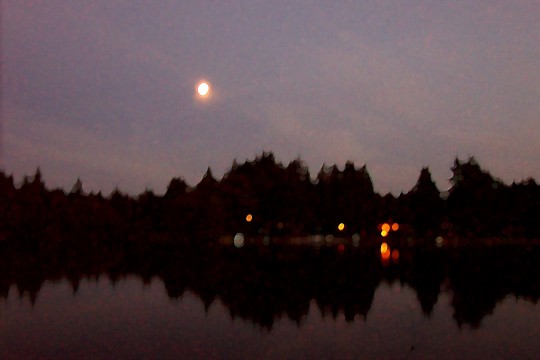
Early moonrise over Lake Ketchum
|
Archive Search |
| Links |
|
and s-integrator |
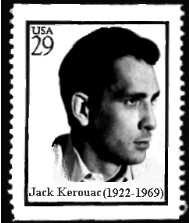
Freedom may not be a breakfast food any longer (courtesy, e. e. cummings) but Jack Kerouac surely was a postage stamp
Okay, so I was wrong. (Ain't you ever been wrong? So what's the big deal?)
Jack Kerouac was much more of a Zen Buddhist than I gave him credit for being. I stand corrected. This has been pointed out to me pointedly, and I have revisited that fine book of nearly 50 years ago, The Dharma Bums, and read a lot of it.
The book is full of serious and intelligent references to Zen and its literature; also Chinese and Japanese poets, especially Li-Po.
Jack says that he was already a Dharma Bum, well versed, when he met Japhy Ryder, who was much more advanced and served as a "master" to him in this and many other ways, such as backpacking and mountain climbing. (Japhy Ryder is a nom de plum for Gary Snyder in the book, as is Alvah Goldbook for Allen Ginsberg.)
The book, in fact, reads like a running account of their adventures in and around San Francisco and the North Cascades of Washington State, where Japhy and our narrator, Ray Smith, were fire lookouts on Desolation Peak.
The Peak itself is a kind of American monastic Zen retreat, compete from its name to its isolation for purposes of contemplation of nature and the meditation that grows from it. It is largely a roman a clef, with direct representations of Jack's friends and companions. Thus, "bow-tied wild-haired old anarchist fuds like Rheinhold Cacoethes" corresponds to Lawrence Ferlinghetti, owner of the City Lights Bookstore in San Francisco, where poetry readings were often held and from which Ginsberg's infamous manifesto Howl was published and sold. (I know, I bought my own copy there then.)
But back to Zen: Japhy (Snyder) was ". . . the number one Dharma Bum of them all and in fact it was he, a kid from eastern Oregon brought up in a log cabin deep in the woods. . . Finally he learned Chinese and Japanese and became an Oriental scholar and discovered the greatest Dharma Bums of them all, the Zen Lunatics of China and Japan. At the same time, being a Norhwest boy with idealistic tendencies, he got interested in oldfashioned I.W.W. anarchism and learned to play the guitar and sing old worker songs. . . ." (p. 10, Signet paper edition.)
When Japhy was asked where he met Ray Smith, he replied, "'Oh I always meet my Bodhisattvas in the street!' he yelled, and ordered beers." (Page 11)
So, among friends, the Zen Buddhist words for complex thoughts and concepts seem to have been in fairly common usage, back in the mid-1950s, which is about as popular as it could ever become.
All over America young people were reading the voluminous work of that most American of writers, Jack Kerouac, famous since publication of On The Road, a year or two earlier, tracking down his sources, and reading those sources for themselves.
There was the inevitable watering down of ideas, and many who became hippies knew only a few tags of Zen, and bastardized them. But, hey, that is how ideas are perpetuated in popular culture, for ill or for good.
Usually it's for the good. Or so the Bodhisattvas might testify.
- - Comments ()
...
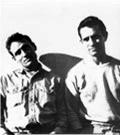
Kerouac and his buddy, Neal Cassady, always friends,sometimes lovers
Jack Kerouac did a lot for Zen Buddhism in the United States, much of it harmful. (Or can anything really do harm to . . . an idea and a religious belief? Hardly.)
He popularized it and made some tags catchwords for a generation of ne're-do-wells--boys and girls, men and women "on the lam." His book, On The Road, popularized the idea of life on the run, life in flight of conventional values. And The Subterraneans gave voice to a concept of alienation not far from Dostoyevsky's Notes From Underground and J. P. Donleavy's The GingerMan, published here in 1958. Of course Ralph Ellison's The Invisible Man (1952), was an important precedent, and Kerouac was well aware of it. Irving Howe and Saul Bellow wrote tellingly of it.
But it was Kerouac in The Dharma Bums who gave particular voice to the Zeitgeist. Every young American intellectual (and many who were intellectual in no good sense of the word) longed to roam America, by car (preferably) or by foot and live off the land in the manner of a mendicant monk.
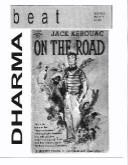
Poster depicting the dharma life on the road
And soon they were, a generation of them who called themselves Hippies (they were Hipsters in scruffy drag) and bummed their way through life. They formed communes (not unAmerican in itself, an idea going back to Thoreau and Hawthorne's times) and subsistence living groups that believed in sharing food and pot.
Getting high was a favorite pasttime, but did not preclude that old American favorite of getting drunk. Kerouac participated in both, but it was booze that finally did him in, but not until after he had run out of words and books to write. His was, however, a remarkable and substantial accomplishment.
It did not much help the cause of conventional Zen, however, which went along its traditional subjective course, quietly and without intrusion into everyday American life. After all, it had weathered centuries of individual and collective seeking for enlightenment.
Kerouac's brand, however, gave the religion and its practice a considerable nudge in a forward direction, and the impact of the Dharma bums condensed Buddhist history into a nutshell.
- - Comments ()
...

Laos Sun-Bathing Buddha
My first real-life experience with Buddhism was just over fifty years ago.
It did not take.
It was 1953, and I had just been inducted into the highly esteemed U.S. Army and was undergoing my basic infantry training at Ft. Ord, California. (Sixth Infantry Division, for those who still care.)
Even then Freedom of Religion was in practice, even though it was largely lip service. Our training was rigorous and we had no free time, except for Sunday mornings, when we were allowed to practice our chosen religion. (Never mind the rest of the week.)
The post at Ft. Ord had a chapel for Protestants, but nothing commensurate for Catholics, let along the handful of Buddhists in our midst. I was a graduate student in English and a confirmed agnostic, perhaps even (gasp!) an atheist. But I insisted on my right to practice my religious free choice.
When I heard there was a Buddhist church or temple (I had never seen it) in Monterey, my religious conversion was instantaneous. At 1000 hours I stood in a short queue to board a chartered yellow bus headed into that seaside bastion of licentiousness and freedom.
An officer checked us in, by which I mean stood with clipboard by the bus's door and wrote down our names and religious preference. Mostly they were Catholic, but a few Orientals said they were Buddhists.
When they came to me, the Captain looked at me incredulously when I said I too was a Buddhist. He smiled sarcastically; I smiled sweetly— Bodhisattavically, I hoped. He let me board. (He had no choice.)
We tooled into Monterey and pulled up in front of a clapboard church—perhaps a former Methodist church gone bankrupt. (It happens.) There we filed inside. The ceremony quickly began. Fortunately for me, it was in English. It didn't seem awfully different from the Protestant ones I had heard in my checkered boyhood.
Except for the psalms, which were in some phonetically translated language, probably Japanese. I sang along, my eyes roving the room, looking at the girls all nicely dressed for church and the day. They were all Oriental.
Pretty, I thought. I had not seen a woman in five weeks. I tried to catch their eyes—any of the attractive young ones. A few shyly let their eyes be caught, linger briefly, then look away. Nice, I thought. My voice boomed with confidence as we moved on to sing the next psalm, or whatever it was.
I was dressed in my Class A uniform and was a pretty spiffy looking young dogface, I thought. But my mind really wasn't on Buddhism or the shiny gold icon up at what corresponded to the pulpit. I wanted a drink. Rumor was, there was a bar just across the street, behind the place, and through an ally. There was a fire exit toward the podium, or whatever, and I took it, found the alley, crossed to the back exit of the bar, and went into the dark interior.
The bar Scotch was Johnny Walker Red Label and it cost—remember, this was a long, long time ago— 50 cents a shot. By the time church was estimated to let out, I had imbibed my fair share. I stumbled back to the alley and exited the church, or whatever, by coming round the side and perhaps waiting a minute or two, or else joining the migration a little late, and merging with the soldiers boarding the bus.
My, how short they all were.
And then it was back to Ft. Ord and our quotidian military life. Slowly my buzz wore off. The Buddhist message was entirely lost. It was not regained for decades, and only then through sporadic reading.
Thank you, Alan Watts and Jack Kerouac. Even though you didn't get the Zen message quite straight.
The message is—get ready for this: "There Is No Message."
- - Comments ()
...
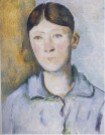
Here she is again, our gal, Hortense Fiquet.
She became Mme. Cézanne a few years after bearing him a son
Paul Cézanne's wife, Hortense Fiquet, was estranged from her painter husband, for most of their married life. Both were intensely shy. She was the subject of many oil paintings and appears often in the Sketchbooks. She and their son remained close to the maternal side of his family, however. And the artist always asked affectionately about her, when he wrote to his son. (Or else this was simply a convention.)
Cézanne drew and sketched for most of his life, and sometimes tore out a page of one of the short-sided bound volumes to give as a gift to a family member of friend. So he contributed, as it were, to their dismemberment. And when he died, Hortense and Paul fils broke up some of the Sketchbooks and sold the loose pages for money, or else allowed them to be removed and laid flat for purposes of photographic copying.

Older now, no less lonely, he continued to sketch her
The Sketchbooks originally were an acute artistic synopsis of Cézanne's life, and as brought back together and cataloged provide a visual history of his life in and around Aix. As art, they are superb. Individual drawings rival da Vinci. As art historian Rishel aptly states, the more than eighteen Sketchbooks form a microcosm of his long career.
- - Comments ()
...
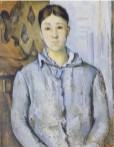
Meet Hortense Fiquet, the mother of Paul Cézanne's namesake son.
She later became Mme. Cézanne and a favorite model,
perhaps because she was usually available to this reticent painter
I lucked into possession of Abrams' wonderful book, Cézanne, when it was remaindered by Hamilton Books, online. (Hurry, there may be another one or two left at half-price. Still, it's $40, but worth it, if anything ever is.)
He made 44 paintings of this plain, severe-seeming woman, and many superb drawings. He met her in 1869, when she was 19 years old, and they soon began living together–not so usual then as it is now, but then, as we all know, "artists are like that."
Their only child was born three years later, in 1872, and they married (mainly to please the painter's mother, who seemingly did not know about the relationship)in 1886, yet his mother continued to run their household until 1889. The painter's unmarried sister continued to live with them, but his mother dominated the scene.
It seems that Paul and Hortense were soon alienated and she spent a lot of time in Paris, with along with his sister, while he remained in Aix. Yet her wrote her—nominally, their son, and always included "warm greetings" to the boy's mother.
Art critic and historian Joseph J. Rishel maintains that "Hortense's head is actually an island of stability and stillness with a tremendously complex and animated construct." I think he is speaking mainly of this painting. She is centered, her brown hair pulled severely back to frame her brow, and her face wears its eternal indoor pallor; she is seen in cool blues and whites, which suggest the opposite of passion.
Rishel may be attributing qualities to Hortense he would like her to have. It would be only natural for her to project a serious, no-nonsense demeanor. Women then mainly did. It was not only fashionable, womanly, but a sign of moral integrity, never mind their child out of wedlock, which hints at a former passion between these two pathologically shy persons that may have been brief.
Whatever, she remains for us to see and marvel at, in these middle-period paintings that are so well executed that one might expect Hortense to come to life and speak some banality (with those never-smiling, never fully formed lips), such as, "Will you be staying for supper, Monsieur?"
- - Comments ()
...
Welcome back, Peripatetic Reader.
Life at the Lake, and other blogs serviced by BlogStudio, have been "down" since Wednesday. That's four long days. What are we blog writers to do, when a power grid failure in far-off Ohio causes a blackout on the East Coast, and so many other places? Why, we are left with a whole lot of words stuck in our mouths.
Here is last Thursday's blog. We'll catch up tomorrow,and (a hint?) soon be turning our attention to our latest obsession, Paul Cezanne. His life and his wife. Not to mention his marvelous paintings.

Sokei-An, as pictured on the front of his book
It is natural to think of Zen Buddhism as a foreign religion now being introduced to our country by a bunch of strangers who do not speak English. This is not exactly the case.
Sokei-An is about as much an American as he is a Japanese. He writes:
"I came to America this last time in 1928, on August 16th, when I landed in Seattle, Washington. I have stayed ten years. On the first day I began to make a hermitage. Everyone helped me. . . .I shall be working for another ten years. I am not doing this for my own purpose; I would be happier in Japan, working with my own people. But I love this country, and have decided to die in this country. Eastern civilization must be brought here; I have been misunderstood. I shall die here, clearing up debris to sow seed. It is not the time for Zen yet. But I am the first of the Zen School to come to New York and bring the teaching. I will not see the end." [Page 164, Zen Pivots.]
I find Sokei-An's words interesting. I do not subscribe entirely, nor do I to Jesus, Bob Dylan, William Yeats, or William Faulkner. Yet I listen to them all, and try to understand what they are saying. It is a universal message.
I am not yet enlightened. But I try to continue to move along on my spiritual journey.
- - Comments ()
...